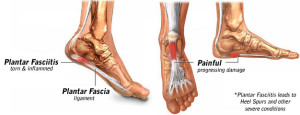 Plantar fasciitis is an inflammation of the band of tissue (the plantar fascia) that extends from the heel to the toes. In this condition, the fascia first becomes irritated and then inflamed, resulting in heel pain.
Plantar fasciitis is an inflammation of the band of tissue (the plantar fascia) that extends from the heel to the toes. In this condition, the fascia first becomes irritated and then inflamed, resulting in heel pain.
Heel pain may be due to other causes, such as a stress fracture, tendonitis, nerve irritation, or arthritis. Because there are several potential causes, it is important to have heel pain properly evaluated and diagnosed.
The most common cause of plantar fasciitis relates to faulty structure of the foot. For example, people who have problems with their arches, either overly flat feet or high-arched feet, are more prone to developing plantar fasciitis. A tight achilles tendon and posterior lower leg muscle group also compound the problem.
Wearing non-supportive shoe gear on hard, flat surfaces puts abnormal strain on the plantar fascia and can lead to plantar fasciitis. This is particularly evident when one’s job requires long hours on the feet. Obesity may also contribute to plantar fasciitis.
Some of the symptoms of plantar fasciitis include pain on the bottom of the heel or arch of the foot. This pain is usually worse upon rising following a period of rest, such as the first few steps out of bed in the morning. This pain usually subsides during the day, but can worsen over several weeks if left untreated.
Diagnosing plantar fasciitis is often done during a clinical exam. However, additional diagnostic imaging studies such as X-rays may be used to distinguish the different types of heel pain. Sometimes heel spurs are found in patients with plantar fasciitis, but these are rarely the source of pain.
Non-surgical treatment of plantar fasciitis begins with first-line strategies, which you can begin at home. The most important are stretching exercises of the calf muscles and achilles tendon.
Icing is another way to reduce inflammation and can be done for 20 minutes, several times a day. Obviously, cutting down on extended physical activity and wearing supportive shoe gear will give your plantar fascia a rest. Also, avoid going barefoot because doing so puts undue stress on the plantar fascia.
By
10/20/2015
Continue reading the original article from The Columbus Telegram here
 Skip to content
Skip to content
